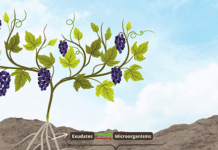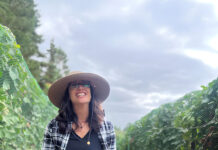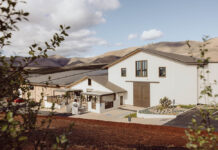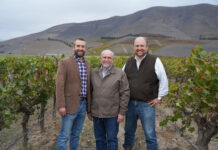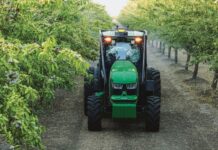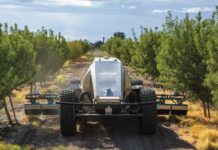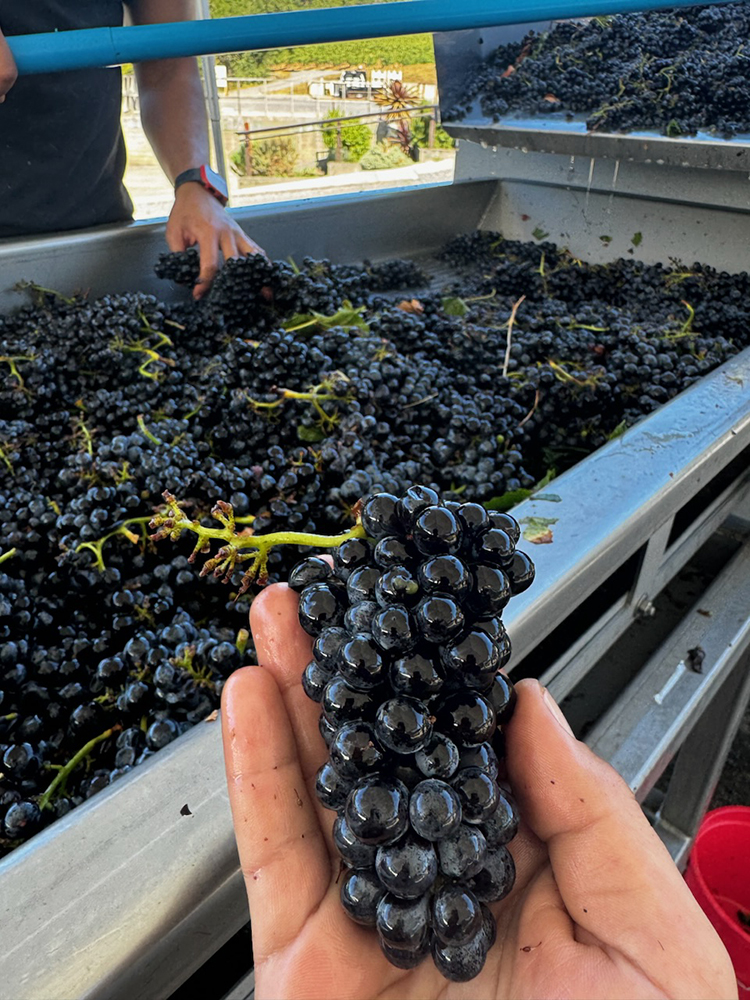
Listen to the audio version of this article (generated by A.I.)
The first time you see an optical sorter operate, it looks like something out of “Star Wars.” Grapes roll by rapidly on a conveyor belt, and before your eye even recognizes a raisin, whoosh! It has been pushed off the belt by a puff of air.
In wine, this technology started with very high-end wineries. The first one this writer ever saw was at a Bordeaux house where the estate wine costs hundreds of dollars and even the second label sells for more than $50. Intense sorting to produce a uniform set of berries has been a goal of many high-end wineries for a generation, but that used to require a 10-person sorting table. In an era when temporary labor is more difficult and expensive to find, an optical sorter can be an economical move.
But for optical sorters themselves, moving into wine meant going upscale. We associate this technology with cult wines, but it comes from the low end of the agriculture business. WECO developed its first optical sorter to sort tomatoes. The first optical sorters used for wine in Europe were adapted from machines that sort blueberries. Today, optical sorters are also used for tree nuts, raspberries, potatoes and olives. These are high-volume, low-margin businesses, but even though expensive, optical sorters make sense for them.
In short, there’s no reason optical sorters should be limited to high-end wineries. And increasingly, they aren’t.
“We have the super-small guys, the super-luxury-high-end people making wine for football guys and people with private helicopters, all the way up to the really large wineries, the big names, like Constellation,” said Glenn Merdan, winery equipment specialist for Pellenc USA. “There’s a time savings; what used to be a 12-hour day they can do in eight.”
Merdan said some of the larger wineries run their harvested grapes through the optical sorter faster than the suggested rate that the Pellenc machine can handle, which is 12 tons per hour.
“Some customers run it at 16 or 18 tons per hour,” Merdan told Grape & Wine Magazine. “But at that rate, there’s so much fruit on the belt that the camera can’t see it underneath. For some customers that’s enough. They just want a quality improvement.”
After you do the capital outlay, it’s quite a bit cheaper. We’re not paying for labor on an hourly basis.
– Stephen Cruzan, Titus Vineyards
What Is an Optical Sorter, and How Does It Work?
An optical sorter is a mechanical sorting table that uses a digital camera and software to recognize anything other than a perfectly shaped, perfectly colored berry. The sorter pushes anything it doesn’t recognize off the belt with a puff of air.
Most optical sorters have multiple settings that allow a winery to decide just how finicky it wants to be. Pellenc’s, for example, has four settings. Merdan said at level one, the sorter rejects leaves, stems and MOG (material other than grapes). Level two has a raisin-rejection mode and has a color slider so wineries can decide to reject light-colored berries in red wine. Levels three and four are like level two, only much stricter.
“At level three, you specifically have the option to shoot a perfect berry with a little stem attached,” Merdan said. “Most customers run at level three with raisin mode. Then with their $200 Cab that they want perfect, they’ll run level four. We see more good berries rejected in level four, but you get a caviar bin.”
Merdan said he has a customer in Canada who makes different levels of reserve wine based purely on the different sorting levels.
It is possible to run the rejected fruit back through the sorter, but Merdan said most wineries don’t do that. However, some do put level-four rejected fruit, which is often four good berries with a leaf in the middle, into a separate tank and ferment it for use in lower-end wines.
The crux of the device is the camera and the programming. However, there’s more to it than that mechanically.
A vibrating table precedes the sorting camera, spreading the berries out across the belt in one layer (unless you run it too fast) so that the camera can see them. (User tip: Optical sorters must have sufficient room light to work properly.) Pellenc’s is one of the fastest, but it is also one of the most expensive. Some machines top out at five tons per hour. The processing rate largely depends on camera and software, but users can adjust the rate.
“The air nozzle bar rejects whatever we set it to reject: little stems, little pieces of leaf, a wire clip, maybe a snail,” Merdan said. “Our machine doesn’t require any user calibration. It’s super easy. It doesn’t require a technician to operate. There are almost 100 air nozzles that fire a blast at a bad object that pushes it into a waste auger. The good fruit moves 2.5 feet per second. It flies across and goes into a bin or a must pump.”
Optical sorters may have different programming, but physically they all work the same basic way.
“We use the WECO system optical sorter,” said Aaron Pott, who owns Pott Wine Company in Napa and also consults for several wineries. “It is as good as the programming that goes into it. It is very good for raisins and MOG if adjusted correctly. Jacks are more difficult as they are often attached to perfectly good berries.”

Are Used Machines Worthwhile?
An obvious issue with optical sorters is cost. A new Pellenc sorter costs more than $100,000. WECO and Bucher Vaslin have models that are cheaper but still cost more than a new sports car.
Stephen Cruzan, winemaker for Titus Vineyards in Napa, was able to buy Chappellet’s old machine, a Key Technology Vitisort, in time for the 2023 vintage.
The Vitisort for wineries is no longer produced. Large agricultural equipment company Duravant, which also owns WECO, bought Key Technology in 2018. Key still makes optical sorters, but not for winegrapes anymore.
Optical sorting technology advances rapidly, so a machine manufactured in 2015 may not have all the control features of one produced today. Also, sourcing replacement parts could be an issue. But there’s a huge difference in price.
“We looked at buying a WECO. Those are $80,000,” Cruzan said. “For us, I couldn’t quite make that make sense. It’s not just $80,000. You have to buy an air compressor and do some upgrades. Ultimately, that didn’t pencil out for us. Buying the used machine was about $18,000. We were able to pay for it in two vintages.”
When writing this article, I went to four online sites for used winery equipment but did not see any optical sorters listed. You may have to know someone. It might be worth sidling up to your friends at high-end wineries and asking if they are thinking about upgrading their own.
Cruzan wasn’t a complete believer in the technology until he tried it.
“Prior to 2023, we had done everything hand-sorting,” Cruzan said. “We could do a decent job of targeting jacks and petioles. Anything that was green could really stand out to the people that were sorting. We could slow the machine down and catch it. But now that we’ve worked with the Vitisort for two vintages, we can go about twice as fast with our crushing. The sorting we’re doing is considerably better than we were ever doing before. After you do the capital outlay, it’s quite a bit cheaper. We’re not paying for labor on an hourly basis.”
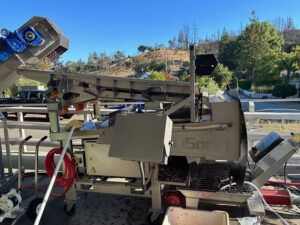
Most Important for Red Wines
It’s possible to use an optical sorter to make white and sparkling wine. But most wineries use them solely for red wines.
Schramsberg Vineyards in Calistoga makes some of the best sparkling wines in California. Schramsberg President Hugh Davies says he’s very happy with the Pellenc Selectiv’ Process Vision 3 he bought two years ago for his Cabernet brand, Davies Vineyards.
“It does a nice job of screening out the runt berries or raisins,” Davies said. “It does it so quickly that it saves on labor costs, but it also does it very efficiently. It’s really amazing.”
But Davies doesn’t see the point in using it for the company’s sparkling wines, because the juice and skins (and MOG) will be separated very quickly in the winemaking process, instead of soaking together for two weeks as they might for red wines.
“There everything is loaded into the press,” Davies said. “It’s whole cluster. We’re not fermenting in contact with the skins. We’re pressing the juice out. It’s a completely different process.”
Davies also said because grapes for sparkling are picked earlier, they tend to be firmer, with fewer broken berries. And, he said, optical sorters are best for destemmed grapes because the sorter can then treat lingering stems as something to be removed.
Schramsberg does use the optical sorter for some batches of Pinot Noir that go into its sparkling rosés. But he said even for still wines, he changes the setting for less rigorous sorting of Pinot than Cabernet.
“Generally speaking, we are screening out a little bit less on the Pinot side,” Davies said. “We’re picking a little less ripe; around 14% alcohol is targeted. You’re not going to have quite as many raisins. With Pinot Noir, we might have a little more tolerance for green berries as well. On the Cab side, we accept fewer green berries. We’re picking it riper so you’re going to be kicking out a little bit more, up to 5%.”
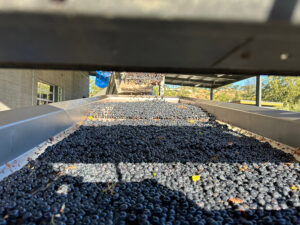
This Year Mildew, Next Year Raisins
The adjustability of optical sorters is important because every vintage presents a different problem to be sorted out.
In a rainy year, broken berries should be avoided because they could have mildew. Newer machines can be set to recognize berries by the shape. Berries that are not perfectly round can be assumed compromised and are rejected.
Increasingly, though, excess heat is the greater problem facing West Coast wineries. Heat waves can cause winegrapes to shrivel into raisins. A generation ago, this might not have been a problem. Essentially, Mother Nature is recreating the “appassimento” grape-drying process used to make Amarone. But raisins raise the potential alcohol of wine at a time when many wineries are striving for greater balance.
“We can target raisins; we can’t eliminate 100% of them but we can eliminate most of them,” Cruzan said. “That became especially important in 2024 after that extensive heat wave we had in September.”
Merdan said developing Raisin Mode was one of Pellenc’s most important upgrades between its original version and the current machine.
“In 2022, we added a special raisin-rejection mode: Super Raisin Mode,” Merdan said. “We have a built-in safety for if we have a good berry right next to the raisin because that’s a net loss. We would normally skip that raisin because it would reject the good berry. But in raisin-rejection mode, it would push that raisin out. You’ll have more good berries in the rejection bin.
“In ’22, we had a big heat wave,” Merdan said. “We had a lot of raisins, and people wanted to make sure they got rid of all the raisins, even at the cost of good berries. Our customers are okay with sacrificing for a clean bucket of fruit.”
That said, some wineries still prefer to sort winegrapes the old-fashioned way.
“No, we are not using an optical sorter,” said Georg Salzner, president of Castello di Amorosa in Calistoga. “We are a medieval castle.”


